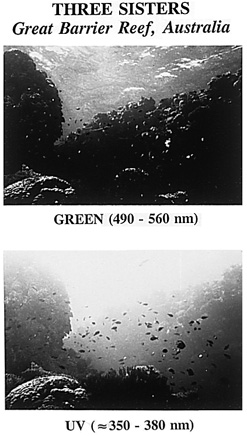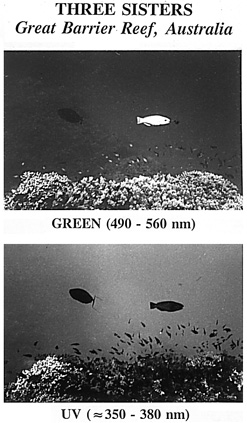| Welcome | Research | People | Publications | Galleries | Courses | Links/Resources | Tech Guides |
|
The Effect of Ultraviolet Vision on Predation The issue of ultraviolet transparency is particularly intriguing. Recent research has shown that UV radiation is more abundant in near-surface ecosystems than previously supposed. This presents two problems for zooplankton that have evolved a concealment strategy based on transparency.
The first involves UV vision among potential predators and prey. UV vision has been demonstrated in many marine species and it has been conservatively estimated that there is sufficient UV light for vision down to 200 m in clear ocean water. Visual pigments with UV sensitivity (though not necessarily peaking in the UV) have been found in the Atlantic halibut, 22 (out of 41 examined) species of coral reef fish, juvenile salmonids, and decapod and stomatopod crustaceans. Among freshwater teleosts UV vision appears to be fairly widespread. Several researchers have hypothesized that UV vision is primarily used to improve detection of planktonic prey, and some have shown that the presence of UV light improves the search behavior of certain UV-sensitive zooplanktivorous fish. The presence of UV sensitivity in planktivorous but not in non-planktivorous life stages of salmonids, the correlation between UV vision and planktivory in coral reef fish, and the correlation between ocular UV transparency and planktivory all suggest that UV vision is often used to increase the contrast of planktonic prey. The second problem related to UV radiation is potential radiation damage. Numerous studies have shown that pelagic organisms are damaged by UV radiation in various ways, including deleterious effects on DNA, proteins, tissue, activity, growth, reproduction, and chemical defenses. Differential levels of these effects have been shown to influence biomass, sex ratios, and species compositions of both terrestrial and marine ecosystems. These effects are primarily due to UV-B radiation (280-320 nm), and in clear polar water have been observed to depths of 20-25 m. At lower latitudes, where surface UV irradiance is higher, these effects are likely to be observed even deeper.
One of the primary defensive mechanisms against UV radiation damage is the use of UV absorbing pigments. However, because UV-protective pigments must attenuate UV light to be effective, their presence reduces an organism's transparency in the UV, and thus increases its sighting distance for predators and prey with UV vision. This presents a potential dilemma for transparent epipelagic zooplankton: protection or concealment. This conflict is particularly difficult to resolve in clear, oceanic waters where UV radiation levels are high, and camouflage is especially challenging. Reports of decreasing ozone levels at polar, temperate, and tropical latitudes create an additional complication, because transparent zooplankton may face concomitant increases in UV radiation. A responsive increase in UV-protective pigmentation (at either an individual or population level) increases UV visibility, resulting in potentially increased predation or decreased feeding success. A responsive increase in depth may decrease access to prey, phytoplankton, or warm water. We have investigated this topic in several ways. First, we have measured the UV and visible transparency of zooplankton and the waters they inhabit, and then modeled the effect of the measured UV absorption on radiation protection and visibility to UV-visual predators. Second, we have measured the effects of UV radiation on the sighting distance of zooplankton when viewed by the Bluegill in a laminar flow tank. Publications |
|||||||||||||||||||||||||||||||||||||||||
| Duke University | Biological Sciences Bldg, Room 301 | (919) 660-7321 | sjohnsen@duke.edu |

 Research
Projects
Research
Projects
